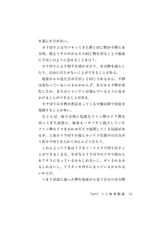Search Results
6/28/2025, 12:34:24 AM
>Let's look at an example where you cut 5s and then next turn 2s. What can your opponents conjecture about your souzu shape from this?
>A possibility is a starting shape of 2235s. Another is 125s, where you cut 5s and then also drop the penchan.
>In case of a penchan drop, the next tile you discard might be 1s. If another player can choose a tanki, he may try to aim for this 1s drop.
>Another conceivable shape is 112s, where you cut 2s to confirm the pair. There are other patterns as well, but what they have in common is that the lower edge of souzu is involved. As you cut 5s before 2s, other than the case where they were both floating tiles and you cut 5s first because 2s is safer, there is a high chance that you have a block in lower souzu.
>If 5s were instead followed by 1s, we can think of possibilities like 122s where the pair was fixed, or 1235s where you drew 4s after and slid your sequence.
>Reading hands is the process of accumulating bits of information like this and making conjectures from there.
>Another effect of tedashi is that it implies the possibility of a hand change. You could have hit tenpai just now, or maybe you changed your wait, or maybe you drew a dangerous tile and decided to break tenpai. You can make the other players consider these options, among others.
>A tedashi tile thus reveals more information. When you can choose between tedashi and tsumogiri, you can tedashi when the information revealed from it benefits you and tsumogiri otherwise.
>With karagiri, you can make your opponents waver, reduce the safe zones available to them, and restrict the way they play their hands.
>To other players, karagiri looks like tedashi, so even though your hand hasn't changed at all, you can make them think that something in your hand changed or that you advanced in shanten.
>Karagiri tends to be most useful starting from the midgame, where hands have been trimmed down somewhat.
>A possibility is a starting shape of 2235s. Another is 125s, where you cut 5s and then also drop the penchan.
>In case of a penchan drop, the next tile you discard might be 1s. If another player can choose a tanki, he may try to aim for this 1s drop.
>Another conceivable shape is 112s, where you cut 2s to confirm the pair. There are other patterns as well, but what they have in common is that the lower edge of souzu is involved. As you cut 5s before 2s, other than the case where they were both floating tiles and you cut 5s first because 2s is safer, there is a high chance that you have a block in lower souzu.
>If 5s were instead followed by 1s, we can think of possibilities like 122s where the pair was fixed, or 1235s where you drew 4s after and slid your sequence.
>Reading hands is the process of accumulating bits of information like this and making conjectures from there.
>Another effect of tedashi is that it implies the possibility of a hand change. You could have hit tenpai just now, or maybe you changed your wait, or maybe you drew a dangerous tile and decided to break tenpai. You can make the other players consider these options, among others.
>A tedashi tile thus reveals more information. When you can choose between tedashi and tsumogiri, you can tedashi when the information revealed from it benefits you and tsumogiri otherwise.
>With karagiri, you can make your opponents waver, reduce the safe zones available to them, and restrict the way they play their hands.
>To other players, karagiri looks like tedashi, so even though your hand hasn't changed at all, you can make them think that something in your hand changed or that you advanced in shanten.
>Karagiri tends to be most useful starting from the midgame, where hands have been trimmed down somewhat.
Page 1
